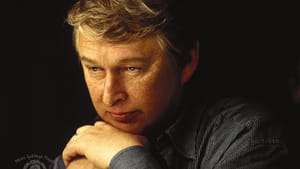Stay in the Loop
BSR publishes on a weekly schedule, with an email newsletter every Wednesday and Thursday morning. There’s no paywall, and subscribing is always free.
Who’s afraid to take a chance?
Remembering Mike Nichols (one)

Mike Nichols was a gambler.
Throughout his career on Broadway and in Hollywood, he took terrific chances. Like most gamblers, when he was hot, he was torrid — but unlike them, when he was not, he was still very warm.
He started out as an actor, a special kind of actor: He did improv. Along with his partner, Elaine May, he created a new kind of comedy, born of the interplay between the two of them. If laughter is the best medicine, take this B-12 shot of a sketch with May and Nichols performing one of their classic routines, the $65 Funeral, still as funny as it was more than 50 years ago.
Not surprisingly, he started his directing career with comedies. In this early phase of his Broadway directing career, his biggest hit was directing Art Carney and Walter Matthau in the iconic Odd Couple.
In 1966, he was given the opportunity to direct the film version of the hit Broadway play Who’s Afraid of Virginia Woolf? Albee’s play brought to life the most caustic couple in American drama, George and Martha. Hollywood decided to cast the most famous couple in the world in the leads, Elizabeth Taylor and Richard Burton. The last time they had made a film together, in Cleopatra, they ruined several Hollywood careers and almost ruined an entire Hollywood studio. This time, instead of disaster, Nichols struck gold. Taylor and Burton turned in two of the best performances of their careers. Here they are being the gracious hosts to a young couple they invited over for dinner – the camera is as drunk as they are.
Who turned down Redford?
His first film was a hit, so Nichols could pick his next project. He decided on a quirky novel called The Graduate. At the film’s heart was a confused college graduate who ends up having an affair with his girlfriend’s mother. Every actor in Hollywood recognized that it could be a career-making role. Nichols had worked with a young Robert Redford on Broadway. Redford lobbied for the part. One night, he and Nichols were playing pool when Redford brought up the subject again. Seemingly changing the subject, Nichols asked Redford about his undergraduate days at the University of Colorado. “So,” Nichols asked, “when you would ask a girl for her phone number, how many of them turned you down?” “Turned me down?” responded Redford, “that never happened.” “And that’s why you can’t play this part,” Nichols responded.
 Instead, Nichols cast an aging unknown actor, Dustin Hoffman, already 30, to play the oh-so-naive Benjamin to Anne Bancroft’s oh-so-sophisticated Mrs. Robinson.
Instead, Nichols cast an aging unknown actor, Dustin Hoffman, already 30, to play the oh-so-naive Benjamin to Anne Bancroft’s oh-so-sophisticated Mrs. Robinson.
Two movies, two hits. Nichols could have played it safe with his next project. Instead, he chose to make a film of that darkest of American comedic novels, Catch-22. His achievement was that he almost made it work.
Finding actors
Most other directors would have taken a step back after that and tried something less risky. Not Nichols. Instead, he decided to make a film about the machismo, still with us today, that destroys most relationships between the sexes. The central characters in Carnal Knowledge are played by a Roger Corman exploitation movie veteran, Jack Nicholson (three years away from his breakout role in Chinatown), and a sexpot known more for her body parts than her acting roles, Ann-Margret.
The usual path for a Broadway director who made a hit film was to abandon Broadway and proceed full throttle with a Hollywood career. Instead, Nichols divided his time between Broadway and Hollywood. He is one of the few directors to win a Grammy (for a comedy record with Elaine May), an Emmy (two as an executive producer and two for Outstanding Directing), an Oscar (Best Director for The Graduate) and a Tony (seven for Best Director and two as a producer for Best Play/Best Musical).
The list of actors he directed on Broadway is mind-boggling: Robert Redford, Elizabeth Ashley, George C. Scott, Alan Arkin, Art Carney, Walter Matthau, Alan Alda, Barbara Harris, Anne Bancroft, E.G. Marhsall, Maureen Stapleton, Julie Christie, Lillian Gish, Nicol Williamson, John Lithgow, Jonathan Pryce, Armand Assante, Hume Cronyn, Jessica Tandy, Gilda Radner, Glenn Close, Jeremy Irons, Cynthia Nixon, Christine Baranski, William Hurt, Harvey Keitel, Sigourney Weaver, Ron Silver, Richard Dreyfuss, Gene Hackman, Morgan Freeman, Frances McDormand, Philip Seymour Hoffman, Rachel Weisz, Daniel Craig, and Whoopi Goldberg.
His work in film was characterized by the great performances he got from his actors. None were more radiant than those of the finest film actress of our time, Meryl Streep, whom he directed in Silkwood, Heartburn, Postcards from the Edge, and Angels in America.
Nichols never developed a style in the traditional sense. His style was the truth. Whether on the screen or on the stage, Nichols found that moment of truth in the story and the characters. Whether the actor was Richard Burton or Harrison Ford, Meryl Streep or Cher, Nichols dug deep into an actor’s psyche and brought forth all the shining truth contained in the human soul.
Today, with all media posed on the brink of a great black hole of change, we need gamblers more than ever.
Above right: Hoffman and Bancroft in The Graduate. (© Metro-Goldwyn-Mayer Studios Inc.)
For another remembrance by Susan Beth Lehman, click here.
Sign up for our newsletter
All of the week's new articles, all in one place. Sign up for the free weekly BSR newsletters, and don't miss a conversation.
 Armen Pandola
Armen Pandola